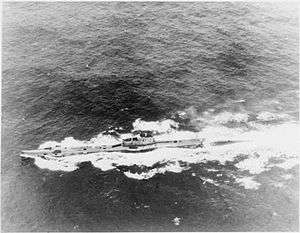Wilfrid Woods
| Sir Wilfrid John Wentworth Woods | |
|---|---|
| Born |
19 February 1906 Southsea, Portsmouth |
| Died |
1 January 1975 (aged 68) Burley, Hampshire |
| Allegiance | United Kingdom |
| Service/ | Royal Navy |
| Years of service | 1919–1965 |
| Rank | Admiral |
| Commands held |
Commander-in-Chief, Portsmouth (1963–65) Home Fleet (1960–63) Flag Officer Submarines (1955–57) HMS Indomitable (1952–53) 3rd Submarine Flotilla (1945–46) HMS Forth (1945–46) HMS Centurion (1944) HMS Triumph (1940–41) HMS Seahorse (1935–36) |
| Battles/wars | Second World War |
| Awards |
Knight Grand Cross of the Order of the British Empire Knight Commander of the Order of the Bath Distinguished Service Order & Bar Order of the White Eagle (Yugoslavia) Grand Commander of the Royal Order of George I (Greece) |
| Other work |
Commodore RN Sailing Association (1963–66) Chairman, RNLI (1968–72) President, Sea Cadet Corps Sports Council (1966) Chairman, Foudroyant Trust (1967) Deputy Lieutenant of Hampshire |
Admiral Sir Wilfrid John Wentworth Woods, GBE, KCB, DSO & Bar, DL (9 February 1906 – 1 January 1975) was a Royal Navy officer who served in the Submarine Service in the Mediterranean.[1]
Family
Woods was born at Genoa Villa, Southsea, Hampshire, the only child of Sir Wilfrid Wentworth Woods (1876–1947), a colonial civil servant, and his wife, Ethel Maud, née Palmer (c.1875–1942). Woods was educated at Seabrook Lodge Preparatory School at Hythe, Kent, before attending the Royal Naval College, Osborne, and then Dartmouth from 1919 to 1923. On 27 January 1930, he married Murray Auriol Ruth Inglis (1907/8–1956), daughter of Charles Stuart Inglis, a retired Royal Navy paymaster. They had one son (who predeceased them) and a daughter. He was widowed in 1956 and, in 1957, he married Joan Bridget Constance Eden, an officer in the Women's Royal Naval Service.
Naval service
In 1927, he joined the Submarine Service and served on HMS L19 on the China Station.

Woods' first command was the modern submarine HMS Seahorse in 1935. At the outbreak of World War II, he was Staff Operations Officer for the 6th Submarine Flotilla at Blyth, Northumberland, before taking his second submarine command, HMS Triumph, to the 1st Flotilla in the Mediterranean, arriving at Alexandria, Egypt in December 1940. Woods' time there saw him savaging Axis supply vessels and warships, including damage to the Italian cruiser Bolzano, as well as landing or recovering military personnel and agents off enemy-occupied shores. In June 1941, he was appointed to the Distinguished Service Order (DSO) for engaging the Italian submarine Salpa in a gun duel and then sinking her with a torpedo.
Woods was decorated with Yugoslavian and Greek orders in recognition of special operations, and a bar to his DSO for "daring, enterprise and devotion to duty". He was promoted to Commander in June 1941 and to Captain four years later. At Normandy, he briefly commanded the old battleship HMS Centurion, which was scuttled as a blockship off the beaches. In 1945, he was appointed Captain (S) 3rd Submarine Flotilla and commander of the submarine depot ship HMS Forth.
He was promoted to rear admiral and became Flag Officer Submarines in 1955 and appointed a CB in 1957. Promoted to vice-admiral, he was Deputy Supreme Allied Commander Atlantic, from 1958 to 1960 in Norfolk, Virginia, where he cemented Anglo-American ties. He was made a Knight Bachelor in 1960. Warm relationships with NATO continued when he was Commander-in-Chief, Home Fleet from 1960 to 1963, and in his final naval post as Commander-in-Chief, Portsmouth from 1963 to 1965.
Between 1967 and 1968 he was Chairman of the Royal Navy Club of 1765 & 1785 (United 1889).[2]
Retirement
In retirement, Woods was a Deputy Lieutenant of Hampshire and, for four years, Chairman of the RNLI. He died on 1 January 1975 at the Royal Victoria Hospital, Bournemouth, Dorset.
References
- Footnotes
- ↑ Houterman, Hans. "Royal Navy (RN) Officers 1939–1945 (N.A. Wodehouse to T.C.T. Wynne)". unithistories. Retrieved 7 May 2010.
- ↑ Royal Navy Club of 1765 & 1785 (United 1889).
- Bibliography
- Richard Compton-Hall, Woods, Sir Wilfrid John Wentworth (1906–1975), Oxford Dictionary of National Biography, Oxford University Press, 2004 accessed 18 Aug 2008
| Military offices | ||
|---|---|---|
| Preceded by George Fawkes |
Flag Officer Submarines 1955–1957 |
Succeeded by Bertram Taylor |
| Preceded by Sir John Eaton |
Deputy Supreme Allied Commander Atlantic 1958–1960 |
Succeeded by Sir Charles Evans |
| Preceded by Sir William Davis |
Commander in Chief, Home Fleet 1960–1963 |
Succeeded by Sir Charles Madden |
| Preceded by Sir Alexander Bingley |
Commander-in-Chief, Portsmouth 1963–1965 |
Succeeded by Sir Varyl Begg |
| Honorary titles | ||
| Preceded by Sir Caspar John |
First and Principal Naval Aide-de-Camp 1962–1965 |
Succeeded by Sir Desmond Dreyer |